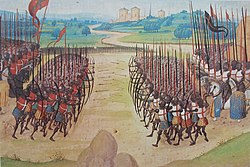This article needs additional citations for verification .(February 2021) |
| Years |
|---|
| Millennium |
| 2nd millennium |
| Centuries |
| Decades |
| Years |

| 1415 by topic |
|---|
| Arts and science |
| Leaders |
| Birth and death categories |
| Births – Deaths |
| Establishments and disestablishments categories |
| Establishments – Disestablishments |
| Art and literature |
| 1415 in poetry |

Year 1415 (MCDXV) was a common year starting on Tuesday of the Julian calendar.